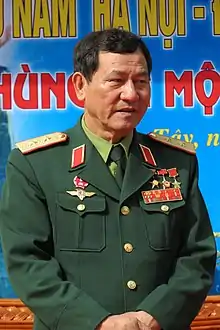Phạm Tuân
Phạm Tuân ([faːm˧ˀ˨ʔ twɜn˨˩] born 14 February 1947) is a retired Vietnam Air Force aviator and space traveler. He became the first Vietnamese citizen and the first non-Soviet Asian in space when he flew aboard the Soyuz 37 mission as an Interkosmos Research Cosmonaut.[1][2] He was awarded the title Hero of the Soviet Union.
Phạm Tuân | |
|---|---|
 | |
| Born | February 14, 1947 |
| Status | Retired |
| Nationality | Vietnamese |
| Awards | Hero of the Soviet Union Hero of the People's Armed Forces Hero of Labor of Vietnam Order of Ho Chi Minh |
| Space career | |
| Vietnam People's Air Force / Intercosmos Research Cosmonaut | |
Previous occupation | Pilot |
| Rank | |
Time in space | 7d 20h 42m |
| Selection | 1979 Interkosmos Group |
| Missions | Soyuz 37 / 36 |
Mission insignia | |
Early life and military career
Phạm Tuân was born in Kiến Xương, Thai Binh province in northern Vietnam. He joined the VPAF, or Vietnam People's Air Force (North Vietnamese Air Force) in 1965, was later commissioned as a combat officer. He flew interceptor missions in a MiG-21 jet fighter against United States aircraft during the Vietnam War.
On the night of 27 December 1972, during Operation Linebacker II (also referred to as the Christmas Bombings), then-Major Phạm engaged a USAF Strategic Air Command (SAC) B-52 Stratofortress heavy bomber using air-to-air missiles. He reported that his missiles struck the B-52, causing it to go down in flames. This claim, which would be the only B-52 downed in aerial combat, is disputed by U.S. records, which state that this B-52 was downed by a surface-to-air missile, also responsible for all other B-52s shot down during the campaign.[3] In a book named "Hà Nội - Điện Biên Phủ trên không" (Hanoi - the Battle of Dien Bien Phu in the air) by Nguyễn Minh Tâm, published by Nhà xuất bản Quân đội Nhân dân Việt Nam (Viet Nam People's Army Publishing House), the author affirms that Phạm Tuân shot down the B-52 with two K-13 air-to-air missiles within a range of 4 kilometers.[4]
Tuân said that because the B-52 was equipped with a large number of infrared decoys, he had to get close to the target (within 2-3 kilometers) in order to ensure the bomber's destruction, though the minimum safe range for launching missiles is at least 8 kilometers.
Tuân received numerous distinctions for his service, including the Ho Chi Minh Order. He also was awarded the Order of Lenin and the rare honor of being one of the few foreigners to receive the title "Hero of the Soviet Union".
Interkosmos program
Tuân reached the rank of lieutenant colonel in the VPAF before eventually training to be a research cosmonaut in the joint USSR-Vietnamese space program. On 1 April 1979, he was selected as a member of the sixth international crew for the Interkosmos program. His backup was Bùi Thanh Liêm. Tuân, along with Soviet cosmonaut Viktor Gorbatko, was launched from Baikonur Cosmodrome on 23 July 1980, on board the Soyuz 37 mission to the Salyut 6 space station.
During his time in orbit, Tuân performed experiments on the melting of mineral samples in microgravity. He also carried out plant experiments on azolla and photographed Vietnam from orbit for mapping purposes. Tuân was in space for 7 days, 20 hours, and 42 minutes, completing 142 orbits, and returned to earth on 31 July 1980.
Personal life
Tuân is married and has two children. He is now a retired lieutenant general, director of the General Department of Defense Industry of the Ministry of Defense, and is a non-elected member of the Vietnam National Assembly.
References
- Toperczer, Istvan. MiG-21 Units of the Vietnam War. 2001, Osprey Publishing Limited. ISBN 978-1-84176-263-0.
- Encyclopedia Astronautica (2007). "Salyut 6 EP-7". Encyclopedia Astronautica. Retrieved October 4, 2007.
- Man-In-Space Firsts
- Toperczer, p. 66
- Nguyễn Minh Tâm (chủ biên). Hà Nội - Điện Biên Phủ trên không. NXB Quân đội nhân dân. Hà Nội. 2008. p. 172.